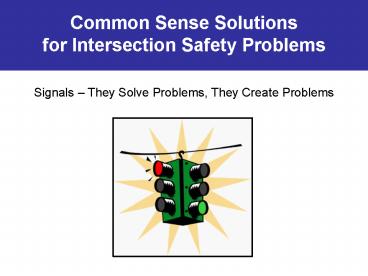Signals They Solve Problems, They Create Problems - PowerPoint PPT Presentation
1 / 29
Title:
Signals They Solve Problems, They Create Problems
Description:
Advance warning signs (with or without beacons) Relocating stop lines. Flashing red beacon ... Manual on Uniform Traffic Control Devices (MUTCD) Part 4 ... – PowerPoint PPT presentation
Number of Views:45
Avg rating:3.0/5.0
Title: Signals They Solve Problems, They Create Problems
1
Common Sense Solutions for Intersection Safety
Problems
- Signals They Solve Problems, They Create
Problems
2
Education Goals
- Understand the terminology used to describe a
signal. - Understand the benefits of properly warranted and
installed signals. - Understand the problems caused by unwarranted or
improperly installed signals.
3
Education Goals (cont.)
- Understand the options available, instead of a
signal, to solve specific problems at an
intersection. - Understand the significance of a signal timing
plan, and the difference between fixed, actuated,
and coordinated signal timing plans. - Understand the uses for the eight different types
of signal warrants
4
Benefits of Signals
- Properly warranted and installed signals
- Increase traffic-handling capacity over 4-way
stops - Enhance the orderly movement of traffic
- Reduce the frequency of left turn straight and
right angle crashes - Regulate speed along a route
- Permit other traffic and pedestrians to cross
5
Problems Caused by Signals
- Unwarranted or improperly installed signals
- Create excessive delays
- Encourage a disregard for traffic signals
- Encourage the use of alternate routes
- Increase the likelihood of rear end collisions
6
Before And After Studies
Of 20 Intersections In Michigan
7
Options to Consider Before Installing a Signal
- To improve visibility
- Advance warning signs(with or without beacons)
- Relocating stop lines
- Flashing red beacon
- Roadway lighting
8
Options to Consider Before Installing a Signal
- To improve traffic operation
- Additional lanes
- Revised geometrics
- Restricted turning movements
- Roundabout
9
Options to Consider Before Installing a Signal
- To reduce speeds
- Traffic calming measures
- Targeted enforcement
- Roundabout
10
Signal Terminology
- Signal Face
- Contains 3, 4, or 5 sections
- Signal Section
- Each light is a section
- Must be red, green, or yellow
- Modern sections are 12 inches in dia.
11
Signal Terminology
- Interval - Period of time that one color
illuminates on the signal face
Red Interval
Yellow Interval
Green Interval
12
Signal Terminology
- Cycle - Series of all intervals
13
Signal Terminology
- Phase - Defined by traffic movement allowed
14
Signal Timing
- Fixed signal
- Operates independent of time of day or traffic
patterns - Actuated signal
- Changes based on time of day or traffic pattern
- Coordinated signal
- Operates within a series of synchronized signals
15
Signal Timing
- Cycle length 60 to 120 seconds
- Green phase 5 to 40 seconds
- Yellow phase 3 to 6 seconds
- All red phase 1.5 to 6 seconds
16
Signal WarrantsWhere to Start
- Manual on Uniform Traffic Control Devices (MUTCD)
Part 4 - Get an engineer involved for a signal warrant
17
Signal WarrantsEngineering Study
- Number of vehicles entering the intersection
- Traffic movement volumes
- Pedestrian volume counts
- Facilities for young, elderly, or disabled
- Speeds (posted and 85)
- Condition diagram
- Collision diagram
18
Types Of Signal Warrants
- Eight-Hour Vehicular Volume
- Four-Hour Vehicular Volume
- Peak Hour
- Pedestrian Volume
- School Crossing
- Coordinated Signal System
- Crash Experience
- Roadway Network
19
(No Transcript)
20
8 Hour Vehicular Volume Warrant Table 4C-1
- Meet condition A, B, or combination of both.
- 100 column Basic warrant volumes.
- 80 column Warranted if other remedies have
been tried first. - 70 column Warranted if speeds gt40 mph in
isolated communities of 10,000 or less. - 56 column - Warranted if A and B are met and
speeds gt40 mph in isolated communities of 10,000
or less where other remedies have been tried
first.
21
4 Hour Volume Warrant
22
Peak Hour Volume Warrant
23
Pedestrian Warrants
- gt100 Pedestrians per hour for any 4 hours, OR
- gt190 Pedestrians per hour for any 1 hour at the
major street - AND
- lt60 gaps per hour during same period
- Volume may be reduced up to 50 for pedestrians
with lower walking speed (children elderly)
24
School Crossing Warrant
- Fewer traffic gaps than minutes in period of
study. - Must be a minimum of 20 students per hour
- EXAMPLE
- Students cross between 730 and 800 30min
- lt30 crossing gaps during this time
- gt20 students present per hour
- (Signal would be Warranted)
25
Crash Experience
- Other alternatives have been tried and failed
- AND
- 5 or more correctable crashes in 12 months
- AND
- Meet minimum volume criteria from
- Criteria A (80 column) Major street for 8hr
warrant - AND
- Criteria B (80 column) Minor street for 8hr
warrant - Or
- 80 of the pedestrian warrant volume
- Can use 56 column (criteria AB) for speeds over
40 mph in communities lt10,000 pop.
26
Traffic Operations Warrants
- Coordinated signals
- Designed to keep vehicles progressing in
platoons - Allows gaps in traffic
- Roadway Network
- For major traffic routes
- Traffic traversing a city
- Entering volumes greater than 1000 vehicles/hour
27
Just for Fun
28
Just for Fun
29
Learn More Ask Questions
I am always ready to learn although I do not
always like being taught. Winston Churchill































